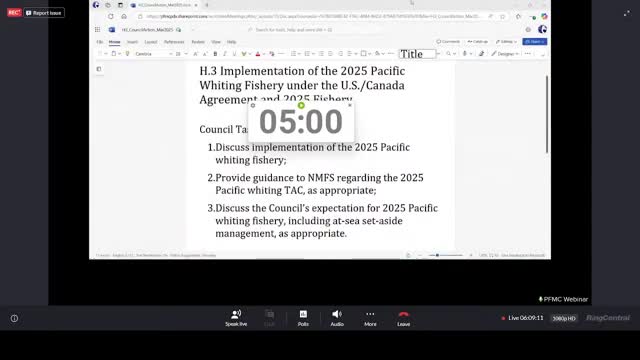Council approves deregulation of Cordell Bank fishing regulations to aid anglers
March 09, 2025 | Fishery Management Council, Pacific, Governor's Office - Boards & Commissions, Executive, Washington
This article was created by AI summarizing key points discussed. AI makes mistakes, so for full details and context, please refer to the video of the full meeting. Please report any errors so we can fix them. Report an error »

The March 2025 PFMC Council Meeting continued on March 8, focusing on significant regulatory changes aimed at simplifying fishing regulations and enhancing opportunities for anglers. The discussions highlighted the culmination of extensive efforts by various stakeholders to ease restrictions while maintaining ecological protections.
The meeting commenced with a recognition of the collaborative work that led to a deregulatory action, which was welcomed by council members seeking to provide more opportunities for fishing with minimal risk to habitats and rebuilding fish species. A motion was introduced by Caroline, proposing the adoption of a preliminary preferred alternative regarding the Cordell Bank area, which included specific coordinates for the hundred fathom depth contour.
The motion received a second from Mark Grolnick, prompting further discussion. Caroline expressed gratitude to council staff and advisory bodies for their contributions, particularly the Habitat Committee for updating the fishing gear impact information. She emphasized that the motion was a response to previous discussions and reflected broad support from advisory bodies and public comments.
A key point raised was the complexity of existing regulations, which have made it challenging for anglers to navigate the rules effectively. Caroline noted that the removal of the Cordell Bank groundfish conservation area tool marked a significant milestone, indicating progress in the conservation efforts for groundfish species. This change is expected to simplify regulations and reduce confusion for anglers.
Additionally, the council discussed the establishment of a groundfish exclusion area to enhance habitat protections in the Cordell Bank region, known for its unique ecological attributes. Despite the reopening of this area for recreational and commercial fishing, it was noted that the actual increase in accessible fishing grounds would be minimal, representing only a fraction of total Exclusive Economic Zone (EEZ) access.
The council acknowledged that various factors, including distance from shore, seasonal restrictions, and weather conditions, would continue to limit fishing efforts in the area. The meeting concluded with an appreciation for the thorough regulatory checks conducted by NIMS and council staff, ensuring that the proposed changes were well-informed and beneficial for both the fishing community and ecological conservation efforts.
Overall, the discussions underscored a commitment to balancing fishing opportunities with the need for sustainable management of marine resources, setting the stage for future regulatory adjustments.
The meeting commenced with a recognition of the collaborative work that led to a deregulatory action, which was welcomed by council members seeking to provide more opportunities for fishing with minimal risk to habitats and rebuilding fish species. A motion was introduced by Caroline, proposing the adoption of a preliminary preferred alternative regarding the Cordell Bank area, which included specific coordinates for the hundred fathom depth contour.
The motion received a second from Mark Grolnick, prompting further discussion. Caroline expressed gratitude to council staff and advisory bodies for their contributions, particularly the Habitat Committee for updating the fishing gear impact information. She emphasized that the motion was a response to previous discussions and reflected broad support from advisory bodies and public comments.
A key point raised was the complexity of existing regulations, which have made it challenging for anglers to navigate the rules effectively. Caroline noted that the removal of the Cordell Bank groundfish conservation area tool marked a significant milestone, indicating progress in the conservation efforts for groundfish species. This change is expected to simplify regulations and reduce confusion for anglers.
Additionally, the council discussed the establishment of a groundfish exclusion area to enhance habitat protections in the Cordell Bank region, known for its unique ecological attributes. Despite the reopening of this area for recreational and commercial fishing, it was noted that the actual increase in accessible fishing grounds would be minimal, representing only a fraction of total Exclusive Economic Zone (EEZ) access.
The council acknowledged that various factors, including distance from shore, seasonal restrictions, and weather conditions, would continue to limit fishing efforts in the area. The meeting concluded with an appreciation for the thorough regulatory checks conducted by NIMS and council staff, ensuring that the proposed changes were well-informed and beneficial for both the fishing community and ecological conservation efforts.
Overall, the discussions underscored a commitment to balancing fishing opportunities with the need for sustainable management of marine resources, setting the stage for future regulatory adjustments.
View full meeting
This article is based on a recent meeting—watch the full video and explore the complete transcript for deeper insights into the discussion.
View full meeting
